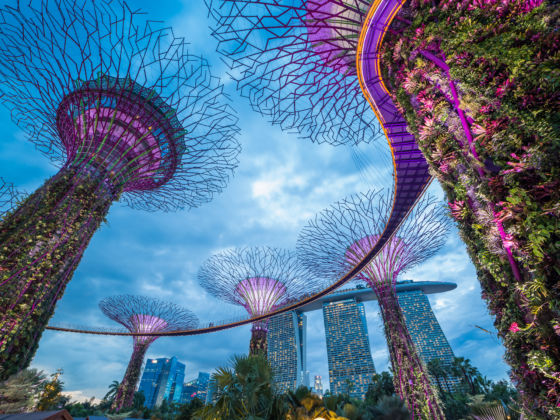Your next backpacking trip to Southeast Asia could be a lesson in sustainable development, at least if Singapore Prime Minister Lee Hsien Loong has anything to say about it. In the near future, he hopes, the region’s important major cities will all have one thing in common: they will be classified as “smart cities.” Other countries throughout Asia are following suit, with India and China standing as additional leaders in the movement.


Smart Cities: These Urban Areas in Asia Are the Cities of the Future
Smart cities are kind of like expanded versions of modern tools you might have in your home – the fridge that monitors your grocery use, the electronic virtual assistant that tells you the weather and plays your morning playlist, the app on your phone that directs you away from an upcoming traffic jam – but across an entire city. Buildings, roads, and people are connected through the Internet of Things, helping to optimize movement across the city and execution of business and daily tasks.
This doesn’t mean that other cities are stupid, per say. Most soon-to-be smart cities are merely everyday cities that are making a concerted effort to improve the lives of citizens. This includes the implementation of systems such as hyper-efficient public transit, rapid response to emergencies and natural disasters, and a seemingly omnipresent ability to access information and utilize services instantaneously. Southeast Asia is taking major steps, and more than 100 other cities across the continent look to do the same. Here are five urban areas across Asia leading the charge.
Singapore
Prime Minister Lee Hsien Loong stands as the de facto leader of the smart cities movement in Southeast Asia, having proposed the ASEAN Smart Cities network and enlisted 26 cities across Southeast Asia to join its ranks. Singapore itself has top-notch public transit, is among the most web-connected cities on the continent, and has taken drastic steps to curb its carbon footprint. In one of its biggest projects in recent years, the city installed 18 solar-powered “supertrees” at their revolutionary Gardens by the Bay area; these trees absorb and disperse heat, assist in rainwater collection and filtering, and provide shade to pedestrians making their way down the walkways beneath. They also look super cool — a perfect compliment to Singapore’s already unique and modern skyline.
Danang, Vietnam
Danang is Vietnam’s fourth largest city and has experienced rapid growth in recent years. By 2020, the city will implement traffic monitoring tools to ease congestion by tracking traffic signals throughout the city in real time, as reported by Nikkei Asian Review. Additionally, the city plans to overhaul technology for crop management in the East Sea coastal area in Central Vietnam within the same time frame. Danang has become a regional tech hub, attracting young talent to work for new startups and established IT companies alike, and is eager to stand out as a leader in sustainable development in the future.
Hangzhou, China
Hangzhou is home to more than nine million people, a colossal city by most standards, even if not unusual in China. In 2016, government officials partnered with tech companies Alibaba and Foxconn to pioneer the “City Brain” project. The idea is to turn Hangzhou into a city that monitors and responds to its own problems immediately and in the most efficient manner possible. This could be a traffic backlog, a safety hazard, a medical emergency, or any number of other issues. Additionally, data collected from the real-time observations will be used to generate models for future development and implementations in hopes of preventing the same mistake, hazard, or emergency from happening again. TechCrunch reported earlier this year that City Brain is also coming to Kuala Lumpur, Malaysia.
Pune, India
The Indian government is on a mission to create 100 smart cities across the country. This project is a long way from reality, but the city of Pune has perhaps the most attainable plan. Pune is in the process of “future-proofing” their city: greening it, making it more liveable, and harvesting the community and its already growing tech sector to optimize city services and transportation. The city hopes to become India’s “most livable” by connecting existing buildings, making transportation greener and more efficient, and improving access to sustainability and green spaces.
Songdo, South Korea
Smart cities aren’t always built from the ground up. The South Korean city of Songdo is one example. This new development 25 miles east of Seoul was designed to eliminate many of the urban woes of Seoul and other overcrowded Asian cities. The city surveys traffic in real-time via sensors in both streets and buildings. Nearly 40% of the city is open space, and the city has a system in place to suck trash from homes and buildings and ‘recycle’ it into energy. A massive wind tower keeps the city cooler than the surrounding area. Bicycles serve as the main form of transit, and the city, which hopes to one day accommodate 300,000 residents, is actually closer to Seoul’s international airport than central Seoul. Songdo is an experiment that was supposed to be fully operational and populated this year — though developers and planners have run into issues attracting residents and businesses to the city. Time will tell how Songdo fairs, but one thing is clear — the ability to build a city around efficiency, sustainability, and remote technology is certainly possible. Like development in general, there’s an element of trial and error. Songdo shows us that there is a way forward.